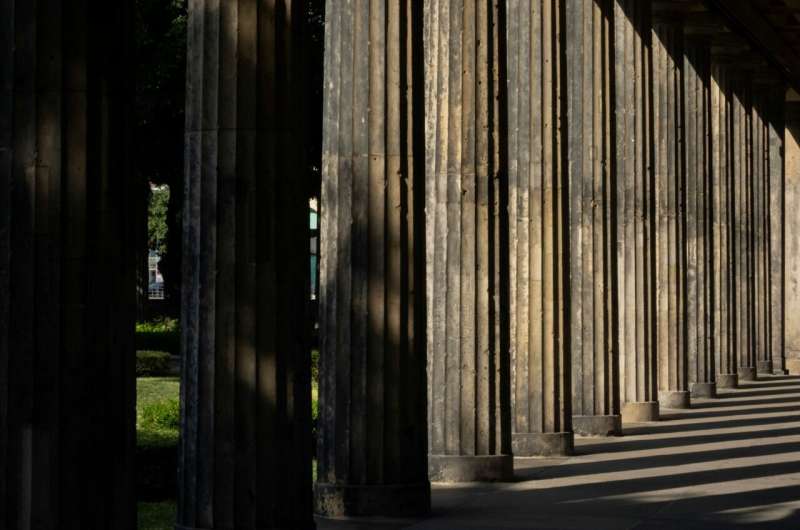This article has been reviewed according to Science X's editorial process and policies. Editors have highlighted the following attributes while ensuring the content's credibility:
fact-checked
peer-reviewed publication
trusted source
proofread
Researchers draw inspiration from ancient Alexandria to optimize quantum simulations

One of the potential advantages of quantum computers that scientists are most hopeful about is molecular simulations. These simulations are too complex for classical computers to perform with enough accuracy, but it's possible that quantum computers could help scientists better understand quantum mechanics and could ultimately lead to new kinds of therapeutics and futuristic materials.
That future may be a step closer: A new algorithm developed at the University of Chicago, drawing inspiration from a famous experiment in ancient Alexandria, could help quantum computers more efficiently simulate molecular systems with high accuracy.
The algorithm, designed by Prof. David Mazziotti and graduate student Irma Avdic, combines a random sampling method with physical constraints to decrease the number of measurements needed to simulate molecules.
The result is a "supercharged" method that brings current quantum computers closer to an advantage over classical computers while laying the groundwork for even better performance on future quantum computing architectures.
"Our algorithm can hopefully bring the potential benefits of predicting molecules with quantum computers closer to reality," said Mazziotti, professor of chemistry and senior author on the study. The research was published in Physical Review Letters.
To better understand quantum systems, combine methods
Understanding a quantum system is extremely difficult. At its smallest levels, nature behaves differently than our classical world, and calculating the huge number of molecular energies and properties within these systems is currently impossible.
Classical computers use approximations to calculate the behavior of a system of more than two electrons, for example. But a quantum computer, powered by qubits that are inherently quantum themselves, has the potential to describe these sorts of systems with much more accuracy.
Still, quantum computing is in the early stages of development, and because of their quantum nature, these computers are inherently noisy, making it difficult to find the correct signal among the noise.
The new algorithm developed by Mazziotti and Avdic helps find that signal by improving a method called shadow tomography. A technique for characterizing quantum states, shadow tomography helps create an "image" of a quantum state by randomly sampling different possibilities of those states.
Those possibilities—essentially "shadows" of the quantum world projected onto the classical world—ultimately provide scientists with enough information to reconstruct the actual quantum state.
Mazziotti and Avdic said their technique was inspired by a breakthrough in the ancient Mediterranean city of Alexandria—where geographers used shadows combined with geometric constraints to learn about the size and shape of the Earth.
But shadow tomography itself isn't enough to efficiently understand systems with more than two electrons (a type of problem known as "many-body problems"). To do that, scientists use a method called two-electron reduced density matrix, or 2-RDM. That method gives scientists the probability of finding two electrons in a field of electrons. That's enough information to predict the electronic properties of the system.
Algorithm could be used to simulate chemical reactions
The team combined these two methods and augmented them by imposing what are called N-representability constraints. These are physical constraints that the 2-RDM must obey (for example, the physical constraints of a system of many electrons).
Ultimately, these constraints and methods combine to allow for fewer measurements that produce less noise. The result is more accurate convergence on the correct simulation of a quantum system.
"Having this additional information dramatically boosts the accuracy of the measurements," Avdic said.
The scientists tested the algorithm on molecular systems and used it to predict important elements of chemical processes, like activation energies. Next, the team plans to press forward, using the algorithm on real applications, such as simulating chemical reactions.
"Just as shadows and geometric constraints played a role in understanding the Earth in ancient Alexandria, we can combine shadows with electronic constraints to learn about molecules on quantum computers," Mazziotti said. "The research brings us a step closer to realizing the potential of quantum computing for molecular simulations."
More information: Irma Avdic et al, Fewer Measurements from Shadow Tomography with N -Representability Conditions, Physical Review Letters (2024). DOI: 10.1103/PhysRevLett.132.220802. On arXiv: DOI: 10.48550/arxiv.2312.11715
Journal information: Physical Review Letters , arXiv
Provided by University of Chicago





















